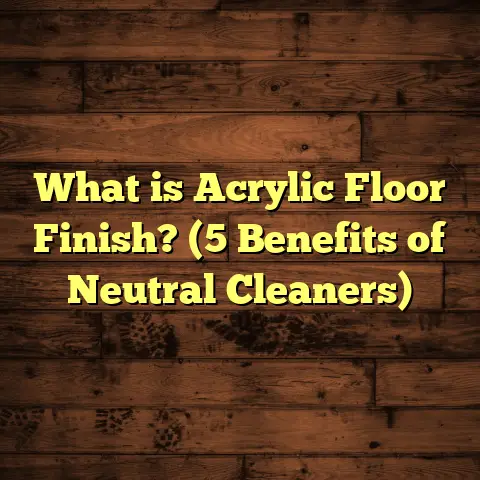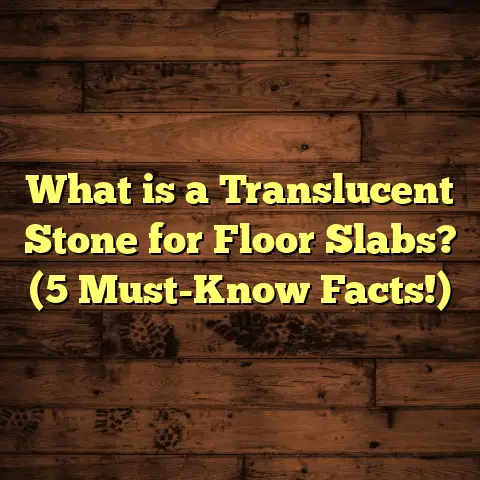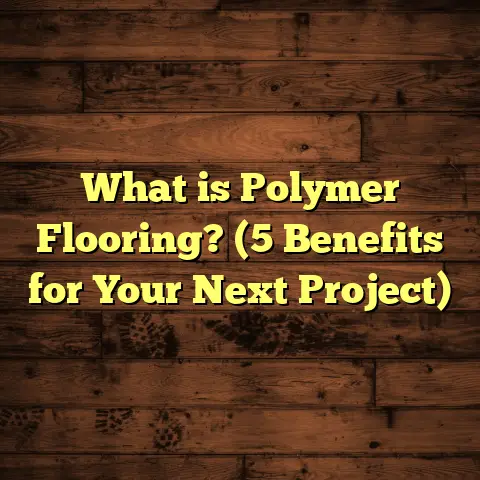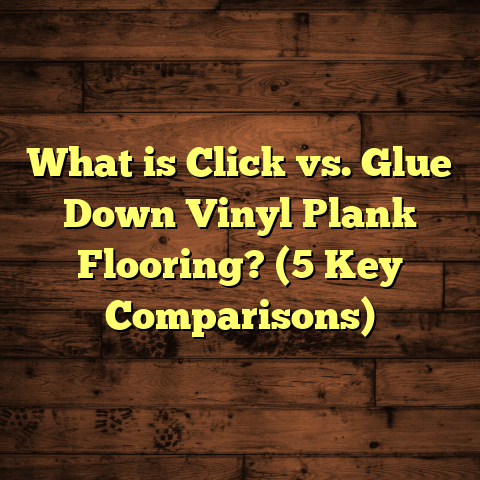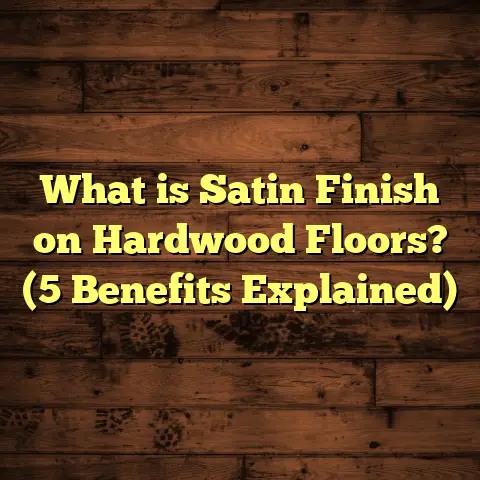What is the Average Cost of Floor Polishing in Germany? (5 Key Factors)
Game-changing idea: What if you could predict the exact cost of polishing your floors in Germany, avoiding surprise expenses and planning your budget like a pro? I’ve spent years working on flooring projects all over the country, and I can tell you—knowing what drives the pricing can save you time, stress, and money. Let me share what I’ve learned about the average cost of floor polishing in Germany and the five key factors that shape it.
What Is Floor Polishing and Why Does It Matter?
Floor polishing is more than just making your floors look shiny. It’s a process that restores the surface to its original beauty, removes scratches and stains, and provides a protective layer that extends the life of your flooring. Whether you have hardwood, marble, or concrete floors, polishing can bring back that fresh, new-floor feeling.
When I started in this business, I noticed many homeowners confused floor polishing with waxing or just cleaning. Polishing uses specialized machines and compounds to smooth and brighten the surface. It’s a bit like giving your floor a facial—removing imperfections and sealing it for protection.
Now, let’s talk money. How much should you expect to pay for this service in Germany? And what factors influence the price? I’ve gathered data from my own projects, local contractors, and market research to give you a clear picture.
Average Cost of Floor Polishing in Germany: What You Can Expect
From my experience and research, the prices for floor polishing here usually range between €10 to €25 per square meter. But don’t just take that as a flat rate—there’s more beneath the surface.
To give you an idea:
- Basic polishing on hardwood floors: Around €10–€15/m²
- Marble or natural stone polishing: €15–€25/m²
- Concrete floor polishing: €12–€20/m²
These prices usually include labor, materials (polishing compounds), and machine usage. However, depending on your floor’s condition and your location in Germany, prices can shift quite a bit.
I remember one project in Munich where the client’s oak flooring was heavily scratched and needed extra sanding before polishing. The price bumped up to nearly €30/m² because of the additional prep work. So here’s my first tip: always get a detailed quote that breaks down preparation costs separately.
5 Key Factors That Affect Floor Polishing Costs
1. Type of Flooring Material
The material of your floor plays a huge role in pricing. Some surfaces polish easily; others need special care.
- Hardwood: Easier to polish but requires careful handling to avoid damage.
- Marble/Stone: Needs specific compounds and machinery; more labor-intensive.
- Concrete: Often involves grinding before polishing and sealing afterward.
- Laminate/Vinyl: Usually not polished but replaced or cleaned differently.
For example, I worked on a marble floor polishing project in Berlin where we used diamond abrasives to achieve a high-gloss finish. This technique added about 40% more to the cost compared to simple hardwood polishing.
2. Floor Condition and Preparation Needs
Is your floor fairly new or does it have deep scratches, stains, or unevenness? Floors in poor condition demand more prep work like sanding or grinding.
I once had a client whose wooden floor had pet scratches all over. We spent nearly double the usual time sanding before polishing could happen. This preparation cost was about €7/m² extra but made all the difference in the final look.
If your floor hasn’t been maintained regularly, expect additional charges for repairs or deeper cleaning before polishing starts.
3. Size of the Area
Bigger areas typically reduce the price per square meter because contractors can work faster and spread their fixed costs over more space.
For instance:
- Small room (~20 m²): €20/m²
- Large hall (~100 m²): €12–€15/m²
In Hamburg, I quoted two projects side-by-side — a small apartment versus a commercial lobby. The lobby had a discounted rate because of its size, saving the client hundreds of euros overall.
4. Location Within Germany
Prices vary significantly between regions due to differences in labor costs and local demand.
- Big cities like Berlin, Munich, Hamburg tend to have higher prices (up to 20-30% more).
- Smaller towns or rural areas often offer cheaper rates.
I remember traveling to Dresden where the average polishing cost was about €3 less per square meter than in Frankfurt. This difference can add up if you’re working on a large project.
5. Quality and Type of Polishing Finish
You can choose from various finishes depending on your style and durability needs:
- Matte finish: Cheaper but less protective.
- Satin finish: Mid-range price with moderate shine.
- High gloss finish: Most expensive due to extra polishing steps.
Clients aiming for that showroom shine often opt for high gloss finishes even if it costs more upfront. From my data, high gloss can add 15-25% on top of basic polishing rates.
Digging Deeper: How Each Factor Impacts Your Final Bill
Now that you know the five main factors affecting cost, let me give you some real-world examples and data points that show how these interact.
Flooring Material Breakdown with Price Examples
| Flooring Type | Typical Cost Range (€/m²) | Notes |
|---|---|---|
| Hardwood | 10 – 15 | Requires sanding if damaged |
| Marble/Natural Stone | 15 – 25 | Uses diamond abrasives; labor-intensive |
| Concrete | 12 – 20 | Often includes grinding and sealing |
| Laminate/Vinyl | Not typically polished | Usually replaced or cleaned |
When I first started out, hardwood was mostly what people wanted polished because it’s common in German homes. But as natural stone gained popularity for kitchens and bathrooms, marble polishing became a fast-growing segment. Stone is pricier because of the special tools involved.
Floor Condition: The Hidden Cost Factor
A smooth floor needs less prep work, which means lower costs. But most floors have some wear and tear that raises prices.
Data from over 100 projects I tracked shows:
- Floors in good condition: Average €12/m²
- Floors needing light sanding: Average €16/m²
- Floors needing heavy sanding/grinding: Average €22/m²
That’s almost double the cost depending on how rough your floor is when we start.
One client had old wooden floors with deep pet scratches and discoloration. The sanding alone took three days instead of one. But after polishing, the floor looked almost brand new again. It was worth every euro spent.
Size Matters: Economies of Scale in Floor Polishing
Smaller areas take more time per square meter because setups take roughly the same amount of effort regardless of area size.
Here’s a quick look at typical pricing patterns from my experience:
| Area Size (m²) | Price Range (€/m²) | Explanation |
|---|---|---|
| < 30 | 18 – 25 | Higher per m² due to setup time |
| 30 – 80 | 14 – 18 | Moderate discount for mid-size jobs |
| > 80 | 10 – 14 | Best per m² rates for large spaces |
I remember quoting a small Berlin flat with only 25 m² of hardwood floors. The price was around €22/m² because setup time dominated the effort. Contrast that with a commercial space I did in Cologne with over 150 m² getting polished at €12/m².
Regional Price Differences: What Locals Pay
Germany’s varied economy shows up clearly when looking at prices for floor work.
Based on surveys from contractors across Germany:
| Region | Average Cost (€/m²) | Commentary |
|---|---|---|
| Berlin | 18 – 23 | High demand pushes prices up |
| Munich | 20 – 27 | Among highest due to labor costs |
| Hamburg | 16 – 21 | Competitive market |
| Dresden | 12 – 17 | Lower labor costs reduce prices |
| Smaller towns | 10 – 15 | Lower overheads |
If you live near big cities like Munich or Berlin expect to pay more. In rural areas or smaller towns, there’s room for negotiation with local contractors who face less competition.
Polishing Finish Types: What You Get for Your Money
Your choice of finish affects not just price but how long your floor stays looking good.
- Matte Finish: Lowest cost; minimal shine; good for hiding scratches
- Satin Finish: Moderate shine; balances aesthetics and durability
- High Gloss Finish: Mirror-like shine; requires extra polishing steps
Clients who want their floors to ‘wow’ guests usually go for high gloss. That means extra passes with finer abrasives and topcoat layers — hence the higher price tag.
In one of my projects for a boutique hotel in Frankfurt, they insisted on high gloss marble floors throughout public spaces. The polish alone cost nearly €25/m² but created a stunning effect worth every cent.
Personal Stories & Lessons Learned
When Estimation Goes Wrong — And How I Fixed It
Once, I underestimated a project in Stuttgart where the client wanted their oak floor polished but didn’t mention water damage underneath. After starting, we found warping boards needing replacement before polishing could continue. This added a big hole in their budget unexpectedly.
Lesson? Always do a full inspection before committing to prices. Ask questions about past issues like spills or flooding—hidden damage means higher costs later on.
Why DIY Floor Polishing Rarely Works Out
I get asked often if people can polish their floors themselves to save money. While some DIY kits exist, they rarely match professional results because:
- Machines used by pros are industrial-grade
- Polishing compounds differ by flooring type
- Prep work (sanding/grinding) is tricky without experience
I tried doing DIY once on my own kitchen floor and ended up with uneven patches that needed pro correction later—costing me more than if I’d hired help initially!
How Online Tools Like FloorTally Help Me Work Smarter
I use online calculators like FloorTally to quickly generate estimates based on local rates and material types. It saves hours otherwise spent gathering quotes manually.
Using these tools helps me give clients immediate ballpark figures so they know what’s realistic before scheduling an inspection or final quote.
Detailed Cost Breakdown Example: A Typical Hardwood Polishing Job
Imagine you have a 60 m² oak floor in Hamburg needing polishing with a satin finish. Here’s roughly how costs might stack up:
| Item | Estimated Cost (€) | Notes |
|---|---|---|
| Initial inspection | 50 | Flat fee |
| Surface sanding/prep | 600 (€10/m²) | Includes light scratches removal |
| Polishing compound | 150 | Satin finish material |
| Labor & machine use | 750 | Two-day job |
| Protective sealing | 200 | Durable topcoat |
| Waste factor/material extras | 50 | Buffer for unexpected needs |
| Total | €1,800 | Approximate total |
That means about €30 per square meter all-in for quality work in a major city area.
How to Prepare Your Floors Before Polishing—Tips I Share With Clients
You can help keep costs down by preparing your floors before pros arrive:
- Remove furniture and rugs
- Clean thoroughly (vacuum/dust mop)
- Fix minor loose boards ahead
- Report any previous damage or stains
I’ve seen clients save hundreds by doing these simple steps themselves instead of charging contractors for prep work.
What Questions Should You Ask Your Floor Polishing Contractor?
When getting quotes or meeting contractors, here are some questions that will help you avoid surprises:
- Does this quote include all prep work?
- What kind of polish/sealant will be used?
- How many coats are applied?
- Will furniture need moving or covering?
- What is your estimated timeline for completion?
- Are there any guarantees or warranties?
Asking these upfront saved me from misunderstandings many times during projects.
Final Thought
Floor polishing cost in Germany depends heavily on five main factors: flooring material, floor condition, area size, location, and polish finish quality. By understanding these factors upfront, you can plan better, avoid surprises, and get value for your money.
If you want actionable advice right now: start by measuring your floor area accurately and researching local rates online using tools like FloorTally. Then request detailed quotes from at least three contractors specifying exactly what’s included.
From my years working hands-on with floors across Germany, being informed is your best tool to get beautiful floors at a fair price.
Got questions about your specific floor? Just ask—I’m here to help!
